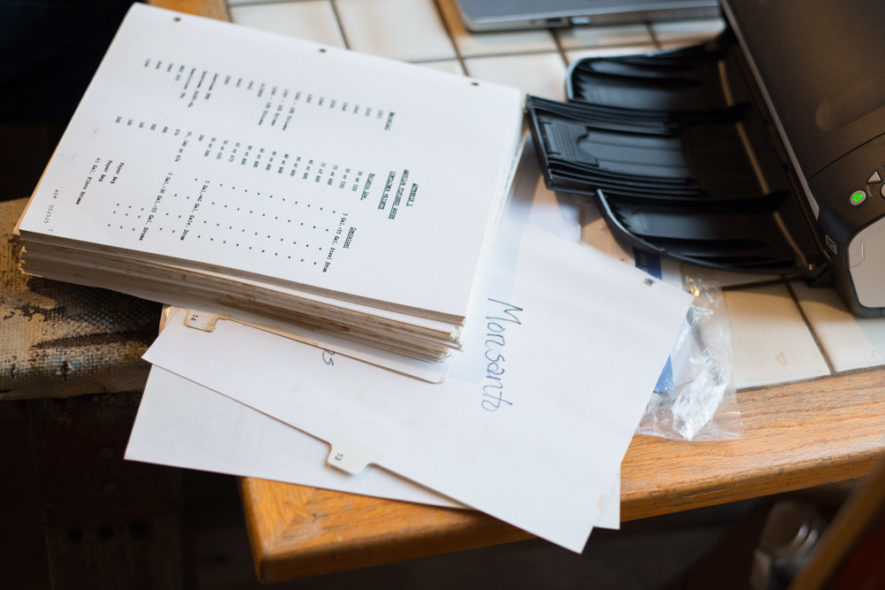The Poison Papers are a unique set of documents that catalogue the secret concerns of industry and regulators over the hazards of pesticides and other chemicals, including their efforts to conceal those concerns from the public.
The Poison Papers comprise around 20,000 documents (over 250,000 pages) obtained from federal agencies and chemical manufacturers primarily via open records requests (FOIA) and public interest litigation. They include internal scientific studies and summaries of studies, internal memos and reports, meeting minutes, strategic discussions, and sworn testimonies. Regulatory agency sources include: the EPA, the US Forest Service, the FDA, the Veterans Administration, and the Department of Defense. Chemical manufacturer sources include: Dow, Monsanto, DuPont, and Union Carbide, as well as many smaller manufacturers and the commercial testing companies who worked for them. Chemicals discussed include many herbicides and pesticides (such as 2,4-D, Dicamba, Permethrin, Atrazine, and Agent Orange), dioxins, and PCBs.
Poison Papers on DocumentCloud

Carol Van Strum sorting the papers
The original documents were largely collected by author and activist Carol Van Strum. Eric Francis Coppolino provided 75,000 pages. Additional documents were provided by Peter von Stackelberg and Diane Hebert.
These documents have been scanned and digitized by the Poison Papers Project and are made publicly available through DocumentCloud, a searchable web repository.
The digitization of the Poison Papers was a project of the Bioscience Resource Project and the Center for Media and Democracy.
Funding for the Poison Papers Project was largely provided by a grant from the Park Foundation. Additional funding was provided by The Bioscience Resource Project and Rosalind Peterson.
Some Poison Papers Revelations
Secrecy— They disclose EPA meeting minutes of a secret high-level dioxins working group that admitted dioxins are extraordinarily poisonous chemicals. The internal minutes contradict the Agency’s longstanding refusal to regulate dioxins or set legal limits.
Collusion— They demonstrate EPA collusion with the pulp and paper industry to “suppress, modify, or delay” the results of the congressionally-mandated National Dioxin Study, which found high levels of dioxins in everyday products, such as baby diapers and coffee filters, as well as pulp and paper mill effluents.
 Deception— They provide important new data on the infamous Industrial Bio-Test (IBT) scandal. By the late 1970s, it was known that more than 800 safety studies performed by IBT on 140 chemicals produced by 38 chemical manufacturers were nonexistent, fraudulent, or invalid. The Poison Papers, however, show that EPA and its Canadian counterpart, the Health Protection Branch (HPB), colluded with pesticide manufacturers, to keep invalidly registered products on the market and covered up problems with many IBT tests.
Deception— They provide important new data on the infamous Industrial Bio-Test (IBT) scandal. By the late 1970s, it was known that more than 800 safety studies performed by IBT on 140 chemicals produced by 38 chemical manufacturers were nonexistent, fraudulent, or invalid. The Poison Papers, however, show that EPA and its Canadian counterpart, the Health Protection Branch (HPB), colluded with pesticide manufacturers, to keep invalidly registered products on the market and covered up problems with many IBT tests.
Cover-up— The papers also show that EPA staff had evidence that this IBT scandal involved more independent testing companies and more products than ever officially acknowledged.
Concealment— The papers show that EPA concealed and falsely discredited its own studies finding high levels of dioxin — 2,3,7,8-TCDD — in environmental samples and human breast milk following routine use of 2,4-D and 2,4,5-T (Agent Orange) by the federal Forest Service and Bureau of Land Management.
Intent— They show Monsanto chief medical officer George Roush admitted under oath to knowing that Monsanto studies into the health effects of dioxins on workers were written up untruthfully for the scientific literature such as to obscure health effects. These fraudulent studies were heavily relied upon by EPA to avoid regulating dioxin. They also were relied upon to defend manufacturers in lawsuits brought by veterans claiming damages from exposure to Agent Orange.
Poison Papers Photography by Risa Scott
